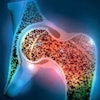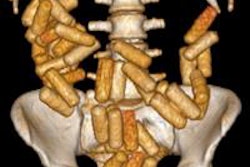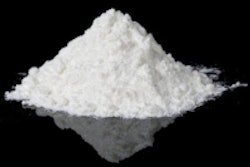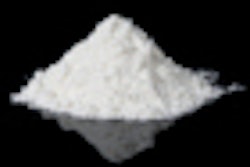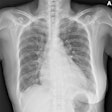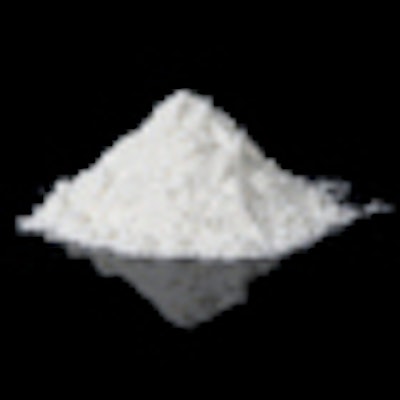
As the global battle against illegal drugs intensifies and criminals become ever more creative about their methods, researchers in Finland are seeking to develop a low-dose CT protocol that may be eventually used to screen suspected traffickers.
Their initiative follows the publication last week of a new study conducted by the group about the practical challenges of interpreting abdominal plain films, which remain the front-line imaging tool in the search for potential drug mules. The research provides details about true positive cases in which even experienced gastrointestinal (GI) radiologists found it difficult or impossible to recognize narcotics in the GI tract, even in retrospect.
"As with any new protocol, starting the screening with CT has been a bit of a hassle. It has, however, been worthwhile. The first experiences have been encouraging," stated lead study author Dr. Markus Sormaala, from the Medical Imaging Center at Helsinki University Central Hospital."With the right optimization, the radiation dosage of a low-dose CT should not significantly differ from traditional plain film images, but both the sensitivity and specificity should be better."
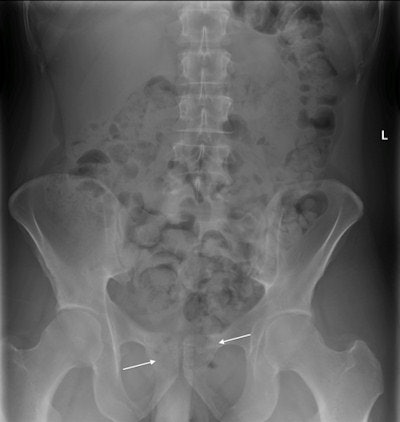 Plain x-ray of a suspected drug smuggler, who later passed two large, regularly oval, 50 x 35-mm hard plastic containers containing illegal substances. The containers are located in the rectum between the arrows. It can be difficult to distinguish them from stool. Image courtesy of Dr. Markus Sormaala.
Plain x-ray of a suspected drug smuggler, who later passed two large, regularly oval, 50 x 35-mm hard plastic containers containing illegal substances. The containers are located in the rectum between the arrows. It can be difficult to distinguish them from stool. Image courtesy of Dr. Markus Sormaala.He thinks there is an urgent need for radiologists to accurately identify drugs in the GI tract. False-negative interpretations may result in a trafficker getting released and the illegal substance ending up on the black market, while false-positive interpretations result in innocent people being detained, which causes expensive and embarrassing delays and poses ethical problems.
For the in-press study by Sormaala and his colleagues, published online on 20 September by the European Journal of Radiology, a total of 279 abdominal radiographs of 224 suspected smugglers were classified by three radiologists as clearly positive or negative for drug smuggling. The cases spanned a period of eight years and eight months. Of the suspects, 75% were male and 25% female. The average age of the male and female suspects in the study was 31.3 years and 30 years, respectively.
Of these cases, 203 (73%) were interpreted as negative and 35 (13%) as positive by all three radiologists. In 86% of the cases there was, therefore, an inter-radiological agreement in interpreting the images. In 41 (14%) cases, however, there was an inter-radiologist disagreement. The Kappa value for interobserver variability was 0.70.
"In up to a seventh of the abdominal radiographs, the interpretation can be challenging even for an experienced radiologist," they wrote. "As negatively interpreted images usually result in release of the suspect, there is no way of knowing how many false negatives occur. This makes the abdominal radiograph a suboptimal examination, and low-dose CT should be considered as the screening modality for gastrointestinal drug smugglers."
Illegal drugs in the GI tract can cause bowel obstruction or intoxication due to ruptured drug packets in the bowel. Cocaine, heroin, LSD, and other illegal substances in pill form are typically swallowed or passed into the colon per rectum, the authors noted. Heroin and cocaine are mostly wrapped in plastic or condoms, to form 2- to 4-cm packages, which are then swallowed. A mule can often store up to 100 packages in their colon and small intestine. Another method is to put drugs into larger 4- to 6-cm hard plastic containers, which are then placed into the rectum. These containers can hold solid drugs, powder, or pills.
Radiologists working in medical centers near large international airports will get plenty of experience of detecting suspected drugs, but many smugglers are imaged in small- and medium-sized institutions, where traffickers are not commonly seen. The image interpretation is often also divided there among several radiologists, resulting in no one of them getting a good routine in the image interpretation. The suspects are also often imaged outside office hours, when an on-call resident-in-training radiologist with limited experience needs to interpret them.
"A large amount of stool in the bowel can be misinterpreted as illegal substances," they noted. "Advised wrapping techniques and a gasless abdomen can make detection of the packages difficult. As only a fraction of the negatively interpreted cases can be verified, it is possible that false-negative interpretations are common."
Therefore, the abdominal radiograph may not be the best modality for screening drug smugglers, and it might be feasible to investigate screening of the suspects with low-dose CT, the author concluded. Also, the study suggests that men are twice as likely to be smugglers than women, meaning that customs officials may be wise to examine more men than women.


